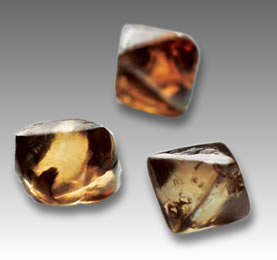Champagne Diamonds
 |
| Rough Champagne Diamonds |
If you've ever wondered what are champagne diamonds, you're not alone. These stunning gemstones, known for their warm, golden hues, have become increasingly popular in the world of fine jewelry. Champagne diamonds are a unique variety of natural diamonds that come in shades ranging from pale yellow to rich, deep brown, often resembling the color of the famous sparkling wine. Discover our collection of champagne diamonds for sale.
Unlike traditional white diamonds, champagne diamonds are celebrated for their unique color and are often sought after by those looking for something distinctive and stylish. The grading of champagne diamonds is based on their color intensity, with darker shades generally commanding higher prices.
For colored diamonds or fancy-colored diamonds, the intensity of color is the most important factor, with clarity, brilliance and fire holding lesser significance. In fact, many fancy champagne diamonds have been known to fetch incredible prices. For example at a Sotheby’s auction in Hong Kong in 2023, a remarkable 6.01 carats champagne diamond known as the "Golden Empire" sold for over $3 million. The color of fancy-colored diamonds is evaluated according to hue (the characteristic color), tone (lightness or darkness of color) and saturation (depth or strength of color).
Diamonds can actually occur in nearly any color, but yellow and brown are by far the most common. In the diamond trade, stones with a yellowish or brownish tone were once regarded as "low colors". Indeed at one time brown diamonds were mainly used for industrial applications.Brown diamonds only began to be marketed in a serious way after the development of the Argyle diamond mine in Australia in 1986. Up until its closure in 2020, the Argyle mine produced about 35 million carats of diamonds per year, nearly a third of the total world production. However, about 80% of the diamonds from the Argyle mine were brown. So the industry faced the problem of a very large supply of brown diamonds with only a small demand.
The jewelry industry adopted two strategies for marketing brown diamonds. Since the supply was large, they were offered at a lower price, usually about 30% less than white diamonds. The industry also introduced new color names to make the product more attractive to consumers. Instead of the dull term "brown diamonds", the terms "champagne" and "cognac" were introduced to make the product more alluring.
Champagne diamond may be substantially more affordable than white diamonds, but they are natural diamonds and display all the virtues of diamond; remarkable hardness (10 on the Mohs scale), a very high refractive index (2.417 - 2.419) and exceptional fire.
It is also worth noting that champagne diamonds are completely untreated. The brown and golden hues of champagne diamonds are produced entirely by nature, in contrast to more vivid diamond colors produced by irradiation or high pressure/high temperature treatment.

